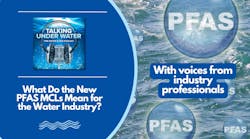U.S. EPA enforcement policy for forever chemicals: It's some protection for water providers but not complete protection
EPA has established drinking water contaminant limits for members of a family of chemicals known as per- and polyfluoroalkyls (PFAS). These include PFOA and PFOS, which recently have been added to the list of hazardous substances under the Comprehensive Environmental Response, Compensation, and Liability Act (CERCLA aka Superfund). PFAS are referred to as “forever chemicals” because they do not degrade in the environment. Exposure to the chemicals has been linked to cancers, impacts to the liver and heart, as well as effects on the immune system and developmental damage to infants and children.
Various entities not involved in manufacturing of, or release of PFOA/PFOS into the environment, are concerned about being held liable for the cleanup of those substances. These entities include drinking water providers, publicly owned/operated treatment works and municipal solid waste landfills, publicly owned airports, local fire departments, and farms using biosolids applied to land.
Under the recently published PFAS Enforcement Discretion and Settlement Policy under CERCLA (Enforcement Policy), the EPA has determined that they will not enforce CERCLA liability for PFOA/PFOS contamination against the above referenced entities. EPA states that this action is consistent with the EPA’s discretionary ability to exercise enforcement under CERCLA. As always, however, there are exceptions to the rule.
Exemptions
Drinking water providers are particularly concerned about potential liability. For such entities, there are two possible avenues to escape possible CERCLA liability. The first is the determination that the Enforcement Policy exempts from liability a “Community Water System,” which is defined under CERCLA as a water system which serves at least 15 service connections used by year-round residents or regularly serves at least 25 year-round residents.
The EPA’s reasoning for this exemption is that such water systems treat PFOA/PFOS contaminated sources of drinking water through their treatment operations and may discharge various contaminated containing residues. They do not use PFOA/PFOS for their treatment processes.
The second potential workaround in possibly escaping enforcement is that that the issue of enforcement is reviewed on a case-by-case basis. Therefore, if EPA contends that the exemption does not apply to a particular entity, the agency states it will apply “fairness and equitable factors” for remediation responsibility based on the “totality of the following factors” to its decision-making process. These factors include if the entity is a state, local, or Tribal government, or if the entity works on behalf of or conducts a service that otherwise would be performed by a state, local, or Tribal government; or whether the entity provides safe drinking water or disposes of PFOA/PFOS contaminated waste.
However, how the EPA defines “equitable factors” is not explained. EPA is likely referencing the “Gore” factors that are often relied upon by the courts in CERCLA litigation. Of those factors, there are only some that would assist an otherwise exempt water. The Gore factors that could apply here are:
- The ability of parties to demonstrate that their contribution to the contamination can be distinguished from others;
- The degree of involvement by parties in generation, transportation, treatment, storage, or disposal of hazardous waste;
- The degree of care exercised by parties with respect to hazardous waste; and
- The degree of cooperation by parties with government prevent harm.
It can be argued that the application of these factors could provide the necessary information to support a decision by EPA not to enforce CERCLA liability against a water provider, if a water provider can demonstrate and establish a positive record on each of the applicable actors.
Contribution Protection
To further CERCLA’s enforcement and remediation goals, EPA could – and should -- provide some measure of litigation and liability protection through settlement agreements. By doing so, the agency would protect a water provider from third-party suit for contribution for their part in the release and remediation of a hazardous substance such as PFOA/PFOS.
The enforcement policy is not complete protection for water providers
Notably, there are three important circumstances under which the Enforcement Policy does not provide complete protection against EPA action.
First, the Enforcement Policy does not bar individual states from making their own rules regarding enforcement of their rules against a water provider. Presumably, most states provide their regulatory agencies and states attorney generals with the authority to make decisions about enforcement and what each state may or may not do is unknown.
Second, the Enforcement Policy is limited only to CERCLA, not to any other program or statute. Accordingly, the EPA could bring an enforcement action against a water provider under a different environmental law.
And third, the Enforcement Policy does not affect EPA’s ability to pursue any entities which are deemed exempt by this policy and whose actions or inaction significantly contribute or exacerbate the spread of PFAS/PFOS and would clearly require a CERCLA response action. This is an issue for a water provider who may “move” the plume of PFOA/PFOS by pumping or recharging. CERCLA liability depends on the specific circumstances, particularly whether the movement of contaminants constitutes a "disposal.” The argument being that moving the plume could make it more difficult or costly for the contaminant’s removal, or move it to areas not otherwise polluted. Thus, if the EPA determines that a water provider, otherwise protected under the Enforcement Policy, is exacerbating the spread of the contaminants, it could use that fact to enforce CERCLA against the water provider.
About the Author
Steven L. Hoch
Steven L. Hoch, Of Counsel, Clark Hill.
Tracy Y. Williams
Tracy Y. Williams, Senior Attorney, Clark Hill.


